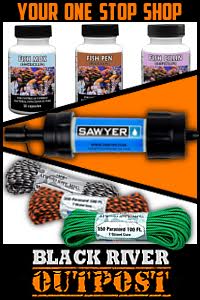By The Maj
Most prepping discussions eventually turn to firearms and then to ammunition. Both are definitely valid topics of discussion and selecting the right firearm, stockpiling the right amount of ammunition, and becoming proficient in its use can make the difference in any survival situation. However, one topic I rarely hear discussed is “what happens when I run out of ammunition?”. When this topic is discussed, the general answer is “I will turn to my trusted bow/crossbow or I have an air rifle, etc.”. The issue here is those items also require manufactured projectiles, just like ammunition, in order to function properly – meaning, in a long term survival situation there will come a day where you will run out. So, the question remains, “what happens then?”.
Have you ever noticed that there are people surviving on this planet today without the aid of mass manufactured items with which to hunt and defend themselves? Sure, most of them happen to be in Africa, Australia, or South America but they also happen to be surviving and thriving in some of the most hostile environments on the face of this planet. This is only possible because they have the knowledge required to develop weapons from their environment, they have developed the skills necessary to be successful with their “primitive” weapons, and when they break, they are only steps away from making a replacement. This ability means life or death for them daily.
In most developed areas, we are at least 75 years removed from utilizing primitive weapons and 150 years removed is more likely, for survival and self defense. This means the skill to fashion or utilize such weapons has been all but lost. These skills will become critical in a long term survival situation and they are skills which need to be developed right now when failure does not mean death. Even if you become proficient in making such weapons, they take hours upon hours of practice before you can consider them a useful tool.
The discussion surrounding “the best” primitive weapons normally gets bogged down just about as quick as discussions of “the best” survival firearms. Just like with firearms this argument will be different for each person, but there are several key factors when selecting primitive weapons that will have to be considered. Primarily these factors include: are the materials readily available in your area to fabricate the weapon and projectiles, dependability of the weapon, primary use of the weapon (defense or hunting), amount of practice each weapon takes to become proficient and the time you can dedicate to becoming proficient, and portability.
As with many areas in the prepping world it will all boil down to individual choice and preference. I will discuss several different types of primitive weapons and add insight with those which I have experience with but you will need to research different types and make a personal decision on those that you consider best for you. The only “must have” I will advocate is the fact that you will need to know how to make and become proficient with two different types of primitive weapons. One should be some type of projectile/distance weapon and the other should be some type of hand/striking weapon which provides more standoff than a knife.
Slingshots and Panas. I am going to go ahead and admit here that I am partial to a slingshot. I own several different models that are commercially produced and I love “shooting” them. I have fully incorporated the use of a slingshot in my preparations to include extra commercially produced bands and ball bearings. My love of slingshots came from having a grandfather that made and used one during the Great Depression to help feed his family and fortunately passed his knowledge on to me. I still have several slingshots that he made in my collection and each is still as functional as the day he made it. Finding a projectile for it is generally as simple as searching the ground for a rock and the band can be replicated utilizing rubber cut from an inner tube, wound and cured animal sinew, or a whole host of other material with elastic properties. The base requires some basic carving skills but with practice a very nice base can be created while sitting around a campfire. The biggest drawback to a slingshot is its limitations for a “kill” on larger game, which also makes it lacking for defensive purposes. Even with these limitations it can be successfully utilized to take various small game, birds, and could disorient or kill a two legged attacker in the right situation.
Panas are an interesting twist on the basic slingshot design and are often referred to as a dart sling. They are still utilized widely in the Philippines today and are made from natural materials, except for the projectiles which use steel. The construction has a base, similar to the slingshot but a Pana only has one attachment point at the base and an attachment ring for the projectile or dart. It operates similar to a slingshot but it should be considered a deadly weapon because of the darts. Darts are typically straight pieces of a hard material (steel, wire, bone, and even wood) with some type of fiber fetching that provides stability for the projectile in flight. Realistically the Pana should still be considered a small game weapon but a head shot on larger animals (including humans) would likely be fatal. The limitations for the Pana come from the skill it takes to craft the projectiles and availability of materials to do so.
Slings and Bolas. King David made the sling famous when he killed the giant Goliath and the weapon saw widespread use even before then. It was a cheap, easily produced, and effective weapon of war for the time but it could also be utilized for hunting. The principle of the sling is simple but it’s mastery is something of another matter. The design of the sling is relatively simple with two equal lengths of flexible rope attached to a pocket in the middle. Projectiles are typically rocks of various sizes depending on the size of the pocket and as the name would signify the power comes from twirling the sling in a circular motion and releasing one end of the rope to “sling” the projectile toward the target. Slings can be produced utilizing rope, cloth, animal hide, sinew, or even strips of rubber from an old inner tube and rocks are pretty much common all over the world. If a person becomes proficient utilizing a sling they can easily take down small game and it would be effective for self defense in many situations. The issues for selecting a sling is it takes a lot of time to develop pinpoint accuracy, the motion and sound of the sling does not allow the user to remain concealed, and the motion required to fire the sling limits it to being utilized primarily in open areas or at a minimum sparsely vegetated areas.
Bolas were developed to entangle the legs of prey and there is evidence they have been utilized to take down game in the range of 200 pounds. They are considered non-lethal but can cause damage (broken bones). Normally bolas are constructed utilizing leather rope or straps which connect to weights on the ends. A typical bola will have two weights of equal size attached to the shorter ropes and a lighter weight attached to a longer rope (grasp ball). The bola is grasped by the lighter weight a spun in a circular motion above the head, upon release the two heavier weights fly parallel to each other with the lighter weight trailing which causes the longer rope to wrap around the legs of the game animal. Since the bola is not considered lethal, it does not offer much in the form of defense, but its ability to take down larger game leaves it open for consideration.
Pocket Bows and Traditional Bows. A pocket bow is pretty much a cross between a slingshot/pana/crossbow/traditional bow. It is constructed utilizing a hollow, pipe like material which will allow the arrow and fletching to pass through when fired. Normally this “pipe” will be six to nine inches long, with an elastic band attached to opposite, outside edges of the pipe. The projectile is an arrow or bolt and will be longer than the typical crossbow bolt but shorter than the typical arrow. Just like with a traditional bow, arrow or bolt length will depend on the arm length of the shooter. Pocket bows can be constructed utilizing hollow bamboo, pvc pipe, or other similar hollow material. The band can be manufactured from the same materials a slingshot band is and attaching it to the “pipe” is normally accomplished with small gauge wire, thread, or braded vine. Constructing the bolts/arrows can become problematic because they need to be constructed out of straight hardwood of the proper diameter and while a carved tip will suffice, most will want or need to fashion an improved tip.
I am certain by this point there are many thinking “why aren’t traditional bows at the top of the list”. Well, unless you are adept at truly creating something from nothing and making it perform to the standards that you expect, then my suggestion is that you not even consider crafting a traditional bow as a primitive weapon. The items I have mentioned previously do not require someone to be skilled in carving and while plenty of people are proficient with shooting bows without sights, most will find a traditional bow more difficult to master. Crafting arrows which fly true and provide the proper amount of force will present a challenge to most as well. While we are on the subject of crafting arrows, please do not even consider crafting arrows from natural materials for modern compound bows and most modern recurve bows. The amount of force delivered by these modern bows causes aluminum arrows to flex dramatically upon release and I do not know of a wooden arrow that can handle that force without a significant chance of splintering in your arm or face. The same goes for fashioning crossbow bolts for modern crossbows out of natural materials. I am not saying do not consider the traditional bow but I am saying your time may be better spent on mastering another primitive weapon that is more suited for you.
Spears. Like the sling, the spear has been around since man first started crafting tools and it is my personal, second primitive weapon of choice. Most everyone has the basic concept of the spear, so I will not go into a great bit of detail about them. However, of all the primitive weapons available they tend to be the easiest to construct from natural materials and present more flexibility in their use(s). Not only can a spear serve as a thrown weapon, it can also be utilized as a walking staff, hand-held stand-off defensive weapon, and an adequate fishing or hunting tool. If you do opt for a spear as a secondary primitive weapon, I would recommend that you go ahead and purchase a commercially produced tip for it and make certain that it is produced for use as a tool and is NOT a reproduction tip. There are many manufacturers out there that make good quality spear tips and specialty tips for fishing or small game. Just make certain when you are buying a tip that it can be fitted to a carved shaft and is not a screw on type tip. Odds are, you will break the shaft many times before you will wear the tip out.
There are a whole host of other primitive weapons out there for you to choose from including clubs, hatchets, staffs, atlatls, pikes, etc. You can choose from a wide variety that suits your personal preferences, fits your budget for time and money, and will give you the peace of mind that you do have options. Also, when considering which primitive weapon(s) you would like to learn to make and master, do not limit yourself to “all natural” materials. In a true, long term SHTF scenario, there will be plenty of manufactured items abandoned that can be utilized to construct a primitive weapon and provide a better substitute for natural materials. The key is your understanding of the primitive weapon(s)’s construction, its capabilities, and being able to utilize it once it is constructed.









2 comments
the simple throwing cross ,two sharpened sticks tied as a cross make several.can certainly stop a person or capable of goats and hogs small deer
The simple throwing stick can take most small game, is easy to carve/make and use but make several because made of natural materials they are also easy to lose and this gives you several chances at the same target! Don’t forget the blowgun/pipe, easy to make (especially from metal pipe) and fairly quick to become proficient at! Nails with a small patch of cloth make usable darts among other things (don’t forget lubricant). And if using a metal pipe, can be used as a spear, walking stick, fighting staff, wire snare stick, etc., this is perhaps the simplest and most versatile of all primitive weapons. Partly flattening one end of the pipe will make it easier to blow through and also to attach different tools to. If fact, if you have a rifle and no ammo, the barrel could be used as a short staff! Good Luck and happy prepping! (GLAHP)